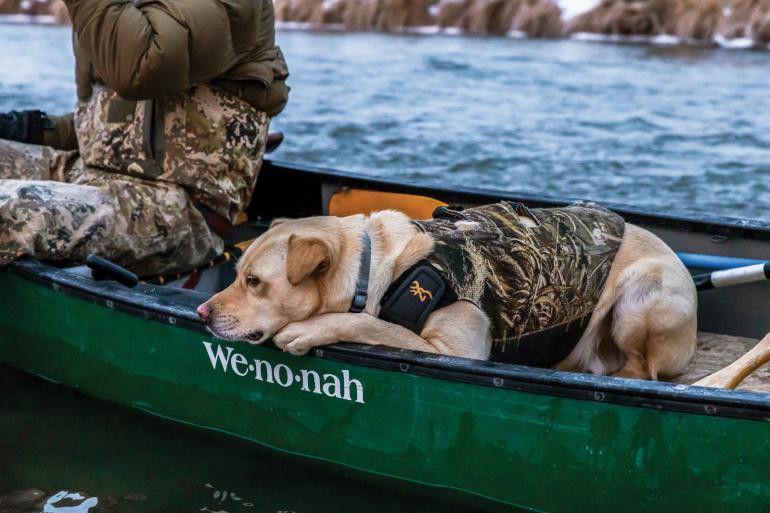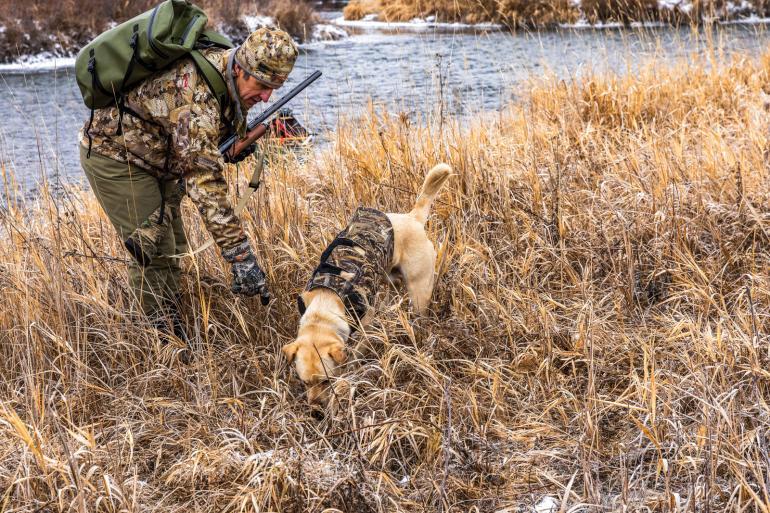Basic Training
Tips on training a hunting dog.
At the shotgun’s report, the mallard shuddered and began a long downward glide into a tangle of brush 100 yards away, across the slough. After chiding my poor shot, I instructed Rosy, my yellow Lab, to heel, stepped out of my makeshift blind, and walked down to the rim of ice around the waterline. Rosy knew I had a bird down, but, curled up at my feet when I shot, she hadn’t seen it fall. She was faced with a “blind” retrieve on a wounded bird far away in dense cover.
I began by instructing her to sit, at my right side and oriented in the direction she needed to go. Then I gave her the line—the direction to the bird—with my right hand and sent her crashing through the ice and water with the command back. As she reached the area where I’d marked the bird, she veered off course, so I commanded her to sit with a hard whistle blast. When she looked back, I directed her over with my outstretched arm. Ten minutes later, she delivered the bird to my hand.
A lot of complex procedures took place during that retrieve, all the result of countless hours of training (and a naturally talented dog). To reach that point, I relied on basic training principles developed during 50 years with multiple breeds meant to hunt anything that flies.
- Define your goals. If you just want a companion dog, admit it. If you want a trained hunter, prepare to invest some time.
- Start slowly. Performance like Rosy’s may take years to develop. Begin with simple, easily enforced commands like sit and heel.
- Avoid distractions. Kids can’t learn when they’re on their cellphones. Dogs can’t learn when they’re playing with other dogs.
- Make commands clear and consistent. Commands should be simple monosyllables. It doesn’t matter what you say as long as you say the same thing every time. Use a consistent, authoritative voice, pretending you’re a drill sergeant. Remember that a command is not a discussion.
- Understand correction and use it wisely. You will need a way to discourage the dog from unwanted behavior, which does not need to be painful or intimidating. A dog that’s hurting isn’t learning. A verbal scolding or open-handed swat will usually suffice.
- Tailor the correction to the dog. Some dogs may need nothing more than a chewing out, while others will require progressively harder swats to make the point.
- Don’t use an electric collar unless you know how. Electric collars probably produce more controversy than any other training subject. Used properly, they can be humane and effective, especially in the field where the dog may be hunting some distance away. Used improperly, they can be a disaster. See below.
- Don’t be afraid to ask for help. If you hit a snag, asking for advice from an experienced friend or professional trainer may be the easiest way around the problem—for you and the dog.
- Don’t issue a command unless you are ready, willing, and able to enforce it. This may not be possible in the field, but it should be in training situations. If you tell a dog to heel and it doesn’t, unless you put it on a leash and make it heel, you have just taught it to ignore the command.
Whole books have been written about training dogs. (Beginners should find those by the late Richard Wolters especially helpful.) Space constraints limit my ability to tell inexperienced trainers all that they need to know, but the principles outlined above should help no matter what breed you are training or what kind of hunting you are training it to do.
Based in Lewistown, Don Thomas has been training hunting dogs for over 50 years.














